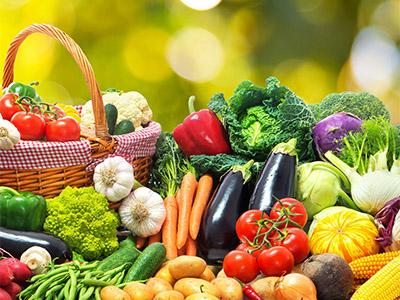Introduction
The importance of healthy diets in the prevention of diseases is widely recognised. However, current dietary intakes of the Scottish population do not meet the Revised Dietary Goals for Scotland and, in addition, are having a significant negative environmental impact. Indeed, the food system in the UK is responsible for approximately 20-30% of our greenhouse gas emissions. Therefore it is imperative to consider the sustainability of healthy diets.
The area of healthy and sustainable diets is complex, with a wide range of multi-dimensional factors playing an important role in the adoption of such diets, including personal factors, environmental factors, and social and economic factors. At the moment, we need a better understanding of how these factors can be combined to optimise the diet of the Scottish population. It is indeed critical that these factors are considered together to avoid unintended consequences in the different sectors, and to be able to communicate a single clear message about dietary advice to consumers.
Climate change mitigation and tackling the poor dietary intakes of the population are both priority areas highlighted in the policy document ‘Becoming a Good Food Nation’, while reduction in GHGE is a key target for the Climate Change Act (Scotland) 2009.

Aim of Research
Sustainability of Healthy Diets: There is no single healthy, sustainable diet, since there are many different ways of achieving the dual dietary goals for health and environmental sustainability, and dietary intakes and the types of food chosen differ across different populations. This adds to the complexity of assessing and translating dietary advice to consumers. The research in this RD will provide a more comprehensive understanding of healthy sustainable diets in different sectors of the population and how these can be measured.
Progress
2021 / 2022
Literature review and development of a demand model allowed the analysis of environmental impact across 27 food and drink categories for Scottish households and three income groups. Simulation was also used to predict the effect of increasing fruit and vegetable intake on the overall diet quality across socioeconomic groups. Equity of long-term Scottish dietary patterns and implications of policy changes for nutrient quality and greenhouse gas emissions of the diet were discussed with FSS, including unintended consequences of dietary policy changes and their differential effects on consumer segments.
We produced a very large dataset where we modelled the best possible food swaps based on nutrient profile, against GHGE and cost preferences, for around 20,000 daily food intake ‘lists’ available in the NDNS database. This dataset is now available for examination and data analysis. The end-product of a food swap tool is going to be an optimised model and a validated dataset which can be further adapted to make use more personalised, for example based on age/gender, health status and food lifestyle preferences for making individual diets healthier, more environmentally sustainable and affordable.
Analysis of cross-sectional NDNS data from ageing Scottish participants showed no significant differences for animal protein consumption by sex, age, income tertile or SIMD level, but plant protein consumption was significantly different by sex, age, income and SIMD level. A QUALTRICS survey revealed that the majority of consumers shop based on taste rather than looking for healthy options. Those in the least deprived areas mentioned a higher frequency of plant-based products, mostly beans or peas, with lentils mentioned 100% more in Scotland than in England. Across IMD, the main reasons for not consuming plant-based meals were preference for meat and limited budget.
Highlights
-
A comprehensive excel database of 27 food groups and 9 nutritional indices representing Scottish food and drink consumption patterns across 4 socioeconomic indicators, represented by household income.
-
A very large dataset where we modelled the best possible food swaps based on nutrient profile, against GHGE and cost preferences, for around 20,000 daily food intake ‘lists’ available in the NDNS database.
-
Insights into current intakes of meats and plant protein products (frequency and portions), type of shopping (retail sector), current views on plant proteins and beliefs in Scotland and contrast with results from England.
2020 / 2021
New food-based analysis of our NDNS+ database show that the relative proportions of most nutritious, environmentally sustainable and affordable foods in each of the food categories, on a per 100 g basis, are comparable to the proportions in the Eatwell guide, except for the proportion of fruits and vegetables being smaller in our analysis due to higher GHGE and cost, and the proportion of potatoes, bread, rice, pasta, and other starchy carbohydrates being larger, in our analysis, due to lower GHGE and cost. Our food-based analysis, however, shows that variation in nutritional quality, GHGE and cost provides 'food swaps' opportunities to improve diets based on all three indicators, and we developed a list of examples from different food groups with the most nutritious, green and affordable food choices.
We assessed the implications of increased/decreased demand for Scottish made ready meals on the ready meals subsector and other interrelated sectors of the economy. We relied on the latest input-output table (2017) from the Scottish government for the analysis. The ready meal subsector which is a component of the “Other food products” sector was disaggregated using the disaggregated input-output analysis. The changes simulated were based on annual sales of Scottish made ready meals obtained from Kantar Worldpanel. Our results suggest that increased demand for ready meals produced by Scottish companies will expand all sectors of the economy, with the greatest impact on the ready meals (8.65 per cent) and other food products sectors (2.13 per cent). Changes in agricultural output were between 0.01 – 0.02 per cent.
We completed a ‘Summary of consumer compliance to Scottish dietary recommendations: A nutritional and economic perspective’. This summary concludes that consumer compliance with Scottish dietary recommendations remains significantly below target, and we have a rapidly evolving paradox of food insecurity and obesity in Scotland. Thus far, untargeted policies and bias towards reductionist approaches to measure complex, inter-related nutritional and economic outcomes, have proven largely ineffective. A holistic approach is necessary to enhance our understanding of these problems and identify barriers to changing consumer behaviour as well as targeting economic resources and incentives according to segmented needs.
Highlights
Further expansion of our NDNS nutrient database+, which now allows the modelling of foods that optimise healthiness, carbon emissions, price, nutrient profiling and processing level, allowing the identification of affordable ‘food swaps’ that produce greener, fresher and healthier individual shopping lists. We submitted this tool into a recent KTP competition) and our pitch was selected to showcase our innovative research to the Food and Drink sector and get feedback from the Food and Drink community online on the 3rd March 2021: https://ktn-uk.org/events/food-industry-innovation-2021-food-nutrition-health/.
2019 / 2020
Application of different modelling approaches is now starting to enhance our insights into dietary intakes that achieve dietary goals for health and are environmentally sustainable. At the same time, such modelling approaches are enabling us to develop tools to help individual consumers choose food products that are contributing to healthy and sustainable diets.
For example, simulation of consumers eating 5-30% less meat or crops as part of a more sustainable diet suggests that this leads to a proportional reduction in land area use, but at the same time to a less than proportionate reduction in carbon emissions and water footprint.
With expertise available at the BioSS, we have now started to apply linear modelling and batch calculation approaches to calculate which foods are the most frequently suggested swaps in the daily records of UK-based citizens who have participated in the NDNS food surveys. The most suggested changes (food swaps) were those reducing foods rich in sugars, sodium and saturated fat, and increasing foods rich in fibre, coinciding with important public health/healthy diet priorities, suggesting that the model works well to identify relevant food swaps.
Highlights:
- Further expansion of the NDNS nutrient database+, which now allows the modelling of foods that optimise healthiness, carbon emissions, price, nutrient profiling and processing level, allowing the identification of affordable ‘food swaps’ that produce greener, fresher and healthier individual shopping lists.
- Follow-up funding from the SEFARI Responsive Opportunity to i) further develop and validate the Greatest Grocery List tool to work with shorter shopping lists; ii) to develop a user interface that will allow easy entry of a shopping list by the consumer and iii) to develop ‘educational messages’ that will make it easy for customers to understand why any swap is being suggested. The trial of the tool as part of a KE event (Food Expo event in Birmingham) had to be postponed due to COVID-19.
- Completion of an extended SEFARI fellowship at Food Standards Scotland to investigate what food products of animal origin flow into and out of Scotland.
- Completion of the systematic literature review: “What is the impact of food and drink based taxes”, researching and modelling food and drink based taxes for Scotland.
2018 / 2019
Microeconomic modelling to estimate demands for whole households are now indicating that sustainable diets will result in carbon emission reductions of 30-55%, as well as improving nutritional quality as measured by the Mean Excess Ratio (MER). Once these economic effects were modelled on the wider Scottish economy, our data indicate that sustainable diets may result in an increase in output value and in an increase in full time equivalence jobs created both directly and indirectly.
We finished the development of the UK NDNS nutrient database+ with entries for GHGE values, nutrient profiling values (FSA/Ofcom and NRF8.3), nutrient composition values and average supermarket pricing for 5798 UK foods.
Focus group work on has given valuable insights into preferred feedback options on “Communicating Sustainable Diets”.
Highlights:
- Completion of NDNS nutrient database+, which will allow the modelling of foods that drive healthiness, GHGE and price, allowing the identification of affordable ‘food swaps’ that produce greener and healthier shopping lists.
- Receiving SEFARI Responsive Opportunity funding to develop the Greatest Grocery List tool based on the newly developed NDNS nutrient database+
- SEFARI fellowship at Food Standards Scotland to investigate what food products of animal origin flow into and out of Scotland
- Development and dissemination (to 34 stakeholders) of the report “How does what we eat affect our environment? Communicating Sustainable Diets” by Ruth Slater and David Watts
- Presentation "Using household demographic data to estimate demand for sustainable diets" at the 93rd Annual Agricultural Economics Society conference, University of Warwick, UK.
- Completion of the report: "Measuring the impact of sustainable diets on the Scottish Food and Drink Sector", reporting that a sustainable diet would likely result in an increase in output value for the Scottish economy.
- Public Health Nutrition Theme Highlight presentation of “The cost of healthy and sustainable diets as purchased by consumers in Scotland” at the Nutrition Society Summer meeting.
2017 / 2018
Good progress has been made against all four objectives of RD3.2.3 that collectively aim to assess how best to design and achieve a good balance of healthy and sustainable diets. Main findings include that consumers in Scotland responded to the recent food price increase, partly, by wasting less food and therefore buying less food. Although still far from meeting dietary targets, diet quality improved very slightly between 2007 and 2012, with bigger improvements seen in households from more deprived areas. Micro-economic diet models have indicated that shifting to different dietary patterns could reduce dietary carbon emission data by up to 45%, indicating that potentially large gains in terms of ‘green diets’ may be possible. Also, greener diets could potentially lead to an overall positive effect on the output value of the Scottish food and drink industry.
Highlights:
- Presentation “Increasing fruit and vegetable consumption whilst incorporating consumer preferences” at the 30th International conference of Agricultural Economists, Vancouver, Canada. The results presented suggest consumers can increase either fruit or vegetable consumption without large reductions of other food products. However, the
- Completing the report: "Modelling the impact of a sustainable diet on the Scottish food and drink sector"
2016 / 2017
In the first year, we have made good progress with identifying and describing purchasing patterns that are consistent with healthy diets. Dietary reference values, food intake data, and carbon footprint data were mapped to the Kantar database to obtain a description of sustainable healthy diets. Both approaches have used Kantar World panel data that are continuously modified and enriched to allow us to execute data analysis. In addition, we mapped greenhouse gas emissions (GHGE) data expressed as g CO2-equivalents (obtained from a range of sources in accordance to the international PAS 2050 standard) to national food intake data which has subsequently been incorporated into the INTAKE24 programme to allow not only the calculation of individual dietary intake, but also an assessment of the sustainability of individual diets.
Highlights:
- Completion of nutrient database with added GHGE data. Currently this database has been requested by, and shared with, 15 stakeholders, and was used at a series of Greenhouse Gas and Dietary choices Open source Toolkit (GGDOT) events
Future Activities
The end-product of our food swap tool is going to be a user friendly tool based on an optimised model and a validated dataset. This tool will be used in the next programme to identify facilitators and barriers for adopting the most effective personalised food swaps for making individual diets healthier and more environmentally sustainable, whilst at the same time not increasing the cost to young Scottish adults. The tool can be used to monitor, in real time, whether and how physiological, psychological and environmental factors affect the adoption of such food swaps, and assess whether intervention improves markers of health.
Selected Outputs
Publications and other outputs
2016/17
Differences in expenditure and amounts of fresh foods, fruits and vegetables, and fish purchased in urban and rural Scotland. (2017) – paper published in Public Health Nutrition by Baukje de Roos et al.
2017/18
Dietary patterns of households in Scotland: differences by level of deprivation and associations with dietary goals. (2017) – paper published in Nutrition and Health by Stephen Whybrow et al.
Simulating the Impact of Carbon Taxes on Greenhouse Gas Emission and Nutrition in the UK. (2018) – paper published in Sustainability by Cesar Revoredo-Giha et al.
2018/19
Healthy and sustainable diets that meet GHGE reduction targets and are affordable for different income groups in the UK. (2019) – paper published in Public Health Nutrition by Christian Reynolds et al.
2019/20
Trading on Food Quality due to Changes in Prices: Are There Any Nutritional Effects? (2019) – paper published in Nutrients by Cesar Revoredo-Giha et al.
Blog posts
What food products of animal origin flow into and out of Scotland?
2021/22
Peer-reviewed publications
Nutritional quality, environmental impact and cost of ultra-processed foods: a food-based analysis (2022) – paper published in Int J Environ Res Public Health by Aceves-Martins et al
Food-level analysis to identify dietary choices with the highest nutritional quality and lowest greenhouse gas emissions and price (2022) – paper published in Front Nutr. by Aceves-Martins et al
Expenditure and nutritional impact of banning the promotion of foods high in fat, sugar and salt in Scotland - paper published in Front Nutr. by Revoredo-Giha et al
Gateway blog
Diet inequalities and food patterns in Scotland
Other
A pdf file with infographics based on the main findings of the work on 'Healthy, sustainiable and affordable food choices' as presented to the nutrition team at FSS




